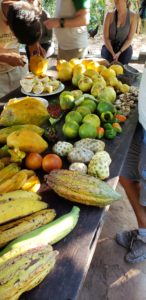 One of the many activities offered by Tambopata Eco Lodge is a visit to the nearby farm that supplies most of the produce served to guests and staff.
One of the many activities offered by Tambopata Eco Lodge is a visit to the nearby farm that supplies most of the produce served to guests and staff.
As our boat neared the dock, we were greeted by the farm’s friendly dogs. The first task was to feed the numerous free-range chickens. After that, our guides displayed most of the fruits grown on the farm and explained what each one was. Sampling many of the fruits was the best part of the tour. We tried papaya, plantains, lady-finger bananas, carambola, lemon, orange, grapefruit, and fish-eye peppers. Noni, a super-fruit related to the acąi which looks a bit like a spotted potato, was the least favourite; the consensus was that it smells and tastes like stinky feet or blue cheese.
Cocona looks a little like a persimmon and is locally called a peach tomato. The lodge chefs use it along with fish-eye peppers and wild coriander to make a spicy sauce served with several of our meals.


We also got to see and taste what chocolate looks like before it is processed. The cacao pod is cracked open to reveal a cluster of fleshy white bulbs about the size of Brazil nuts. In the raw form, the pulp can be eaten, but the cacao seeds must be dried and roasted. The pulp has a tart flavour, similar to a citrus fruit such as lemon or grapefruit. That was very surprising to me.
Cacao’s cousin, the cupuazú, was also sampled. It is often used for juice and in desserts.
Our guides later took us for a walk around the 40-hectare farm to see the fruit groves. We saw most of the fruits already mentioned, as well as avocado, coffee, lime, and cinnamon. The most entertaining was the lipstick plant, which we tested out, but unfortunately there were no mirrors around.
The highlight of the farm visit was seeing the trees full of cacao pods. I have been vindicated. I always said chocolate is a fruit!
If you’d like to go on an adventure to Peru, contact me and I can help you plan your Peruvian adventure!







